#Namibian food is best
Text
The Best News of Last Week - March 20, 2023
🌱 - Okra to the Rescue and Other News You Can't 'Lettuce' Miss This Week
1. 4 day work week being pushed in Congress

Progressive Democrats, led by Rep. Mark Takano of California, are pushing for a four-day workweek to give Americans more time for leisure outside of work. The proposed Thirty-Two Hour Workweek Act would amend the Fair Labor Standards Act of 1938 to require overtime pay for any employee working more than 32 hours in a week at a rate of time and a half.
More than 70 British companies have started to test a four-day workweek, and halfway through the six-month trial, most respondents reported there has been no loss in productivity.
2. Governor Walz signs universal school meals bill into Minnesota law

Minnesota just became the fourth state in the US to provide breakfasts and lunches at no charge to students at participating schools! The bill was signed into law by Governor Tim Walz on Friday, and it's set to ease the burden on parents who struggle to provide meals for their children.
The new legislation will cover the cost of meals for all students, regardless of household income. This means that families who don't qualify for free and reduced meals but who struggle to pay for food will also be covered. The bill is also meant to prevent "lunch shaming" practices, where children are denied food or given substitutes that indicate their family is struggling financially.
3. Texas Researchers Use Okra to Remove Microplastics from Wastewater

Researchers from Tarleton State University in Fort Worth, Texas discovered that food-grade plant extracts from okra have the power to remove microplastics from wastewater. Polysaccharide extracts from plants like fenugreek, cactus, aloe vera, tamarind, and okra were found to be effective non-toxic flocculant alternatives to remove microplastics from water.
Polysaccharides from okra and fenugreek were best for removing microplastics from ocean water, while a combination of okra and tamarind worked best for freshwater. Furthermore, plant-based flocculants can be easily implemented in existing water treatment facilities.
4. In the northern California snow, stranded cows are getting emergency hay drops
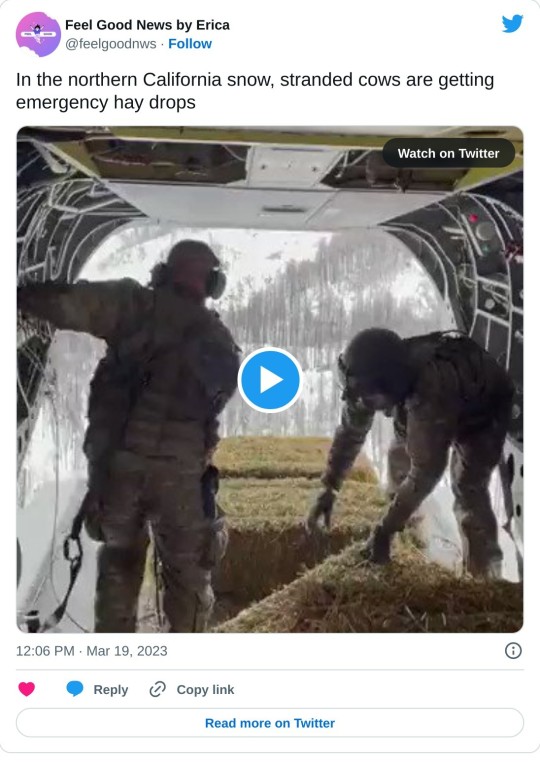
The recent wave of unprecedented snowfall in California has left cattle stranded and starving. When rancher Robert Puga ran out of hay, neighboring Humboldt County officials put together an emergency rescue operation called "Operation Hay Drop." State, federal, and local officials airdropped stranded cattle bales of hay to feed them.
Humboldt County Sheriff William Honsal went to the Coast Guard with the idea of a helicopter rescue, and by midday Sunday, March 5, Operation Hay Drop was underway. So far, Operation Hay Drop has been a success, said rancher Puga. The mission covers about 2,500 head of cattle over several miles.
5. Make-A-Wish Foundation no longer considers Cystic Fibrosis to be automatically qualifying due to improvements in life outcomes for patients

Given the ongoing life-changing advances in cystic fibrosis, beginning in January 2024, cystic fibrosis will no longer automatically qualify for a wish.
6. 1st woman given stem cell transplant to cure HIV is still virus-free 5 years later

In 2017, a woman known as the "New York patient" underwent a stem cell transplant to treat both her cancer and HIV. Now, about 30 months later, she has been virus-free and off her HIV medication, leading some researchers to suggest that she may have been cured of HIV.
The New York patient, received stem cells taken from umbilical cord blood that also had the HIV-resistance genes. However, it's important to note that there is no official distinction between being cured and being in long-term remission, and the medical team is waiting for longer-term follow-up before making any definitive statements.
7. Cheetahs Back in Wild in India After Seven Decades
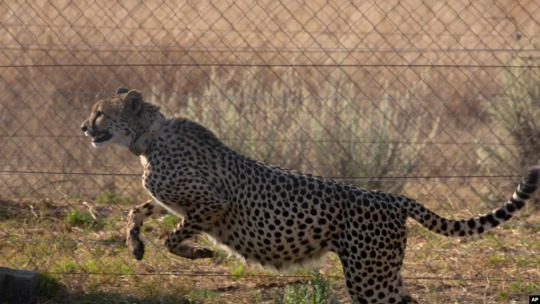
Namibian cheetahs have been successfully reintroduced to India after the world's fastest land animal was declared extinct in the South Asian country more than 70 years ago. Two cheetahs, Obaan and Asha, were released into the wild of Kuno National Park after being brought to India last September.
The species is being reintroduced on an experimental basis as part of a major prestige project for Prime Minister Narendra Modi. India aims to bring in about 100 of the big cats over the next decade. The African cheetah is a different subspecies from the extinct Asiatic cheetah, which once roamed the sub-continent in great numbers.
Lastly, I recently opened a Youtube channel. Subscribe for a weekly compilation of feel good videos.
- - -
That's it for this week :) If you liked this post you can support me with a small kofi donation:
Buy me a coffee ❤️
Let's carry the positivity into next week and keep spreading the good news!
640 notes
·
View notes
Text
Top 10 food in namibia botswana victoria falls
Namibia, Botswana, and Victoria Falls are three of the most popular tourist destinations in Africa. With their stunning landscapes, diverse wildlife, and rich culture and history, it is no surprise that these countries attract so many visitors each year. However, one thing many travelers overlook is the delicious food these countries have to offer. From succulent seafood dishes to spicy stews, Namibia, Botswana, and Victoria Falls each have their own unique culinary delights. In this blog post, we will be exploring the top 10 must-try foods in these three countries. Whether you are looking for a light snack or a hearty meal, these 10 dishes will tantalize your taste buds and keep you coming back for more.

The 5 best foods in Namibia
1. Namibian Fish: The country’s rich waters are home to some of the best fish in the world. From the staple hake to the more exotic tiger fish, there’s something for everyone to enjoy.
2. Potjiekos: A traditional South African dish, potjiekos is a stew made in a three-legged pot over an open fire. It’s a popular dish in Namibia and can be made with any number of different meats and vegetables.
3. Chilled Watermelon Soup: This refreshing soup is perfect for a hot day in Namibia. It’s made with watermelon, cucumber, mint, and yogurt and is served cold.
4. Grilled Chicken: Chicken is a popular choice of meat in Namibia, and it’s often grilled over an open fire for extra flavor. Try it with piri piri sauce for a truly Namibian experience.
5. Cape Malay Curry: Another popular dish from South Africa, Cape Malay curry is a spicy curry made with chicken or lamb, tomatoes, potatoes, and masala spices.
The 5 best foods in Botswana
Botswana is a landlocked country located in Southern Africa. The country is home to a variety of flora and fauna, making it an ideal destination for nature lovers and adventure seekers alike. Botswana is also home to some of the best food in the world. Here are 10 of the best foods you can find in Botswana:
1. Seswaa: This dish is made with beef or chicken that has been slow cooked until it is incredibly tender. The meat is then shredded and mixed with onions, tomatoes, and a variety of spices. It is typically served with pap (a type of cornmeal porridge) or rice.
2. Morogo: This dish is made with spinach or other leafy greens that are cooked until they are soft. They are then mixed with onions, garlic, and a variety of spices. Morogo can be served as a side dish or as a main course.
3. Bean Stew: This hearty stew is made with a variety of beans, including black-eyed peas, lima beans, and kidney beans. The stew also contains tomatoes, onions, garlic, and a variety of spices. It can be served with rice or bread.
4. Chicken Curry: This curry is made with chicken that has been cooked in a curry sauce made with coconut milk, tomatoes, onions, garlic, and a variety of Indian spices. It can be served with rice or bread.
5. Beef Stew
The 6 best foods in Victoria Falls
Victoria Falls is one of the most popular tourist destinations in Africa, and for good reason. The Falls offer a breathtaking natural wonder, and the nearby town of Victoria Falls is full of great restaurants, cafes, and bars. Here are 10 of the best foods in Victoria Falls that you shouldn't miss out on:
1. Zambezi River Trout - The Zambezi River is home to some of the best trout in Africa, and you can find it served up fresh at many restaurants in Victoria Falls.
2. Biltong - This cured meat dish is a staple of South African cuisine, and you can find it served in many different ways in Victoria Falls.
3. Braai - A braai is a South African BBQ, and you'll find plenty of places serving up this delicious grilled food in Victoria Falls.
4. Cape Malay Curries - These curries are a specialty of the Cape Malay community in South Africa, and they're not to be missed while you're in Victoria Falls.
5. Peri-Peri Chicken - This spicy chicken dish originates from Mozambique, but you can find it all overVictoria Falls. It's usually served with rice or potatoes.
6. Vegetarian Food - There are plenty of great vegetarian options to be found in Victoria Falls, so don't worry if you're not a meat-eater.
Conclusion
In conclusion, Namibia, Botswana, and Victoria Falls offer a rich and diverse culinary scene that is sure to satisfy any food lover. From traditional barbecues and stews to unique game meats and fresh seafood, there are many delicious dishes to discover in this part of Africa. Be sure to try some of these top 10 foods when you visit the region to experience the flavors and cultures of Namibia, Botswana, and Victoria Falls.
1 note
·
View note
Text
5 Fascinating Places To Visit In Namibia
Namibia is the most fascinating country in the south-western part of Africa. The country is well known for its diamond industry and its San culture. The country is home to several natural attractions. Some of the places that cannot be missed while you are in Namibia These are Fish River Canyon Park and Epupa Falls.
If you have included in your Namibia vacation fun-filled activities such as being adventurous and fond of nature photography, then Namibia is an ideal place to explore. If you are planning to travel across the country with specific itinerary plans, then connect to the Satguru travel agency for more details.

Let’s read about some of the fascinating places to visit in Namibia.
Namib-Naukluft National Park
The Namib-Naukluft National Park consists of the Namib Desert and the Naukluft Mountain Range. With a beautiful scenic view, it’s the largest game reserve in Africa. The park is made up of red sand dunes, and a shifting landscape is the perfect view to see when you are in this wonderful place to visit. You can spot some of the most remarkable high dunes in the lunar-esque landscapes.
Sossusvlei is the most famous area of the park, Namibia's most popular strip of sand, where gargantuan dune fields tower more than 300 meters above the ground. Kuiseb Canyon must also be checked out.
Etosha National Park
Etosha National Park is the second-largest park in Namibia after Namib-Naukluft. At this park, herds of zebra, antelope, and wildebeest can be seen around the waterholes. It’s a great place to experience a self-drive safari. It’s a perfect place that provides incredible safaris to tourists.
Your trip to Etosha National Park would be incomplete without taking pictures of the scenic beauty of the national park. The Two Palms area is a perfect place for the photographers to capture the frame through their digital cameras. Etosha National Park is an ideal place for bird watching. Different species of birds are found in the park. A visit to Etosha National Park would be incomplete without taking pictures of the park's spreading scenic beauty. Namutoni Spring is the perfect place in the park from which you can spot various species of birds. You can enjoy nightlife at Okaukuejo Water Hole. The best thing to do in the park when you are tired of camping and experiencing the wildlife reserves is to relax while taking a spa session at one of the lodges of the National Park. For better accommodation in Etosha National Park, consider Satguru Travel Agency for a better result.
Swakopmund
If you want to see where local Namibians go on vacation, check out the coastal destination of Swakopmund. Originally a German colonial city, Swakopmund boasts a lot of colorful and historic architecture.
Swakopmund is a destination mostly preferred by the local Namibians. It’s considered the coastal destination of Swakopmund. The city is filled with lots of colorful and historic architecture.This city is known to be the adventure capital of Namibia and is easily accessible for several activities. Here, you can relax on the beach, go quad biking in the desert, or enjoy camel safaris. This place is also a center of attraction, serving great international restaurants and delicious food from local restaurants.
Fish River Canyon Park
Next, we are talking about the second-largest canyon park in the world, Fish River Canyon Park. It is known as the Visrivier Afgronde in Afrikaans. The canyon is framed by the Fish River, which is one of the longest in Africa. For hiking, the Fish River Canyon is very popular. Winter months are the best for experiencing hiking. Check the prices for day hiking at Fish River Canyon. Check out the Satguru Travels online booking for more information.
Waterberg Plateau Park
Next, the most popular place to visit is Waterberg Plateau Park. This park is a large sandstone plateau of red sandstone that was procured as a sanctuary for endangered animals. With the help of your guide, you can spot animals like buffalo, antelope, and rhinoceroses.
The park is home to more than 200 species of birds and a perfect breeding ground for Cape vultures. Travelers set aside a week for adventurous or extensive hikes in the Waterberg Plateau Park. For all hikers, April to November is the best time to enjoy hiking with your tour guide.
0 notes
Note
On a scale of 1-10, how delicious is your cuisine?


How can you even rate my food? It is top tier, my friend.
//Sources for the food images: https://www.internationalcuisine.com/namibian-pap-and-fried-cabbage/, https://www.csmonitor.com/World/Africa/2008/0221/p20s01-woaf.html, https://www.food24.com/News-and-Guides/Focus/what-makes-the-perfect-potjiekos-20160916, https://en.wikipedia.org/wiki/Namibian_cuisine, http://www.travelnewsnamibia.com/news/stories/featured-stories/mopane-worms-a-delicious-meal/, https://www.esterkocht.com/namibian-fat-cakes-fried-dough-recipe/, https://www.gondwana-collection.com/blog/eat-food-in-namibia/
24 notes
·
View notes
Text
Let me show you something wholesome that rarely happens when Lewis is in the news…
Here is the Namibian Sun making it public that Lewis has landed in their country

Y’all these comments are pure AF!
Not only are they wishing him the best, they are commenting every place he should visit, food he has to try, and many many comments about how they hope he stays safe and crime doesn’t follow, some even tagged their police saying they should protect him.





I am yet to find a hate or nasty bullying comment. All of them are so precious ❤️
328 notes
·
View notes
Text
Tips on Having an Enjoyable Travel Experience

People who frequently travel on regular basis will often discover that traveling without previous preparation is always a mistake you will repent later. The experience that was supposed to be an enjoyable and exciting will eventually prove to be a tragedy. There are in fact many pros and cons concerning the choice on the mode of transportation that you may choose for his traveling experience.
Whichever mode you prefer comes with its own merits. Planning for each mode of transportation will differ.
Traveling from 1 location to another usually by car is obviously one of the better options if time isn't an issue and provided the distance isn't too much. In comparison to traveling by airplane, traveling by automobile really offers the traveler many significant benefits. These include flexibility concerning time as well as the opportunity to enjoy the scenery along the road. Traveling by airplane may be faster.
But as soon as you get to your destination, you'll need to hire a cab to maneuver around in. But this isn't the case when traveling by automobile. While travel by car has its benefits, it has several hassles of its own. As an example, it's typically quite challenging especially with children around.
To begin with, before the beginning of journey you have to make certain that the car has just gone through proper servicing in the garage. The gas has to be sufficient and you'll have to get a fantastic map to guide you during your journey. It's good to receive a checklist and ask yourself some questions before you begin your journey. You would have to ask questions like how long will it take to achieve and if you attracted sufficient cash for your trip.
Check also if there are hotels along your trip. After all, you'll have to have proper rest after long hours of driving.
One of the enjoyable parts in regards to traveling is attracting one's children along. However, the other side is they could also get fairly annoying. This is certain to be the trickiest part because you will need additional effort to manage them. The only way to counter this problem is attempt to predict their behavior by putting yourself in their shoes. Make it a point to bring along some food since children get hungry easily.
Additionally, toilet trips are extremely necessary especially when your kids are extremely young. If you happen to get near a gas station along the way, figure out whether they have to go to the bathroom. Somehow or another, for some odd reason, kids will mention that they should go to the bathroom. Yes, it can get more than a little annoying. But then, they're just kids right? Besides that, don't forget to bring along their favorite toys, pillows, pacifiers.
Get along some simple medicine for those little emergencies also.
Overall, it's always a good practice to prepare yourself before traveling. Try to anticipate the possible issues that may arise. With the necessary steps in place, your journey should be smooth and enjoyable.
Cheap Adventure Travel Experiences
Inexpensive adventure travel adventures are cropping up in all manner of destinations from Central America to Eastern Europe and consist of many different activities from over landing to volunteering, however for the best in economical travel opt for camping trips where you can really get close to nature and enjoy a wilderness experience like no other.
Fun and exciting camping adventures can be found worldwide, from the outback of Australia and the national parks of North America into the African bush and European valleys.
There are top 3 recommends best cheap adventure experience.
Camping on a Namibian safari - take in the highlights of the fascinating and gorgeous country without breaking the bank. Camping every night enables you to sleep under the stars and actually get under the skin of Namibia.
Provides a step back in time to a Europe of old where life in the backwaters is uncomplicated, country lanes continue to be quiet and ancient forests flourish. Life in lots of the cities, however, is changing quickly, as development occurs in a remarkable speed.
Explore the budget of Eastern Europe - A diverse region where east meets west, Eastern Europe
With such alluring names as St. Petersburg, Krakow, Kiev, Prague and Yerevan, it's no wonder this area of Europe is so popular with travelers. With booming arts and entertainments, the regeneration of historical monuments and mile after mile of untouched nature, travels through Eastern Europe are just as rewarding as they were before the collapse of the iron curtain.
1 note
·
View note
Text
How does one see Namibia? Full of wildlife, massive sand dunes, and vast distances, there’s really only one way to see it all: renting a car and driving yourself. Just be prepared to drive on the lefthand side of the roads, and be ready for very little pavement!
But then, where does one stay in this developing country? You might find some resort-style lodges near the larger towns, but if you’re on a budget like we are, the best option is a campground. Even in the winter, desert temperatures are mild, and precipitation is nonexistent in such an arid climate.

As adventure types, we don’t shy away from camping when we travel, but that activity requires quite a bit of specialty equipment – extra gear we didn’t exactly want to lug all the way around the world with us. Fortunately, there’s a popular solution in Namibia to the needs of both transportation and accommodation.
Hop aboard and see what life was like spending three weeks in our 4×4 camping truck!
About the truck
First things first, let’s talk about the truck that sustained us for 20 days in the Namibian desert.

Our vehicle was like any other truck: four doors, manual transmission, diesel engine, two spare tires, two batteries, two gas tanks, and – of course – four-wheel drive. Aaron was our brave driver for the entire duration. By this point, he was quite practiced at driving on the “wrong” side of the road, and he wasn’t as preoccupied as I was with photography. I spent most of my time in the passenger seat up front… unless I was scouting for wildlife, in which case I sat like the awkward third wheel in movies: dead center in the back (seriously, no one chooses that seat – especially if they’re the only one back there!).
All our gear could be safely stowed in the bed of the truck, secured by a hard canopy with convenient locking access panels on each side. Aside from the occasional need to fill up and restock on food and water, we had all the necessary basics.
About the roads
Driving from the airport into Windhoek, proper, is misleading. The entire route is tarred roads and highways, and the city appears to be quite developed. Even driving several hours north to Etosha, we never left pavement. But once you get into the park and venture elsewhere in the country, you’ll find nothing but dirt and gravel.

We quickly learned that the letters in the road names denoted (more or less) the quality of that road. B roads are generally tarred highways; we really like these roads. C roads are usually fairly well-graded gravel roads. After enough D roads, we learned to look forward to these C roads.
And D roads? Those are the ones we dreaded… small, bumpy, and less-frequently maintained. They often traverse regular river and creek beds. Though these were all dry when we were there (July), I could see these being rather treacherous in the wet season. These are also best described as washboard roads (this is an interesting simulation on how they form), and some got so bad, we had to take breaks to combat motion sickness. We groaned whenever Google routed us to a D road.
Now, some C roads are also washboarded – particularly the more frequented ones and those with faster traffic like the route into Sossusvlei – and some D roads are better than C roads. And yes, there are E and F roads (these are usually barely paths across the desert).
Is a 4×4 necessary?
When deciding on a vehicle for Namibia, we debated back and forth on whether to get a 4×4 truck or an everyday (and far less expensive) car (or some combination of the two). Most roads are dirt that a car could handle (albeit less comfortably), and we weren’t intending to do much off-roading. In fact, we only used four-wheel drive once the entire time we were there. So was the extra expense worth it?
Yes. For a few reasons.
First, it was comforting to have the peace of mind should we get stuck anywhere. We didn’t plan to do anything so extreme as to suspect we’d run into trouble, but in a place as unpredictable as Namibia, we felt better prepared.

Next, while roads could mostly be navigated via car, they’re almost all rough gravel (see above). Four-wheel drive isn’t always necessary, but high clearance certainly came in handy on more than one occasion!
Third, we liked having the option of 4×4 for the one situation where we *really* needed it. The road to Sossusvlei was deep sand and absolutely required four-wheel drive. Being able to drive it ourselves meant we could skip the expensive and time-restrictive shuttle provided by the park.
And finally, it served not only as our transportation for our duration in Namibia; it was also our lodging. While we theoretically could have slept in a car, the tent that came with our truck was far more comfortable.
What comes with the truck?
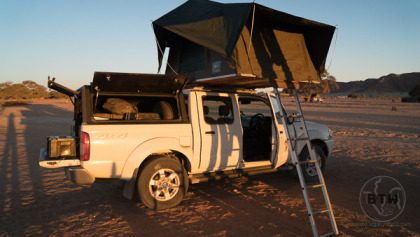
Every company will be different, of course, but ours came fully equipped with everything we needed to live out in the bush: pots, pans, kettle, dishes, can opener (for our favorite Koo Chakalaka), propane, chairs, table, lighter, spare water, a powered refrigerator/cooler, and even a braai (grill).
We were also given essentials like an air compressor, tire gauge, axe, spade, and extension cord.
But what about the tent and sleeping bags?
These come on top of the truck! Yep! No fears of a wayward hyena coming to sniff at tasty human burritos just laying on the ground for the taking in the middle of the night. Sleep in comfort atop your truck!

The tent was surprisingly comfortable. As it’s permanently installed on the roof rack, it can afford the luxury of a real foam pad as insulation. Paired with military-grade canvas above, the inside is quite cozy.
Our truck came with two cool-weather sleeping bags, two full-sized pillows, and a couple of spare blankets should we get cold (we did a few times). This all just stayed in the tent, waiting for us for when we next stopped for the night.
How do you set up the tent?
The setup was a breeze! Far simpler than any other tent I’ve worked with. Come nightfall, we just had to remove the cover, release the tie-down straps, extend the ladder, unfold the tent, and insert the support poles. Boom!
#gallery-0-19 { margin: auto; } #gallery-0-19 .gallery-item { float: left; margin-top: 10px; text-align: center; width: 33%; } #gallery-0-19 img { border: 2px solid #cfcfcf; } #gallery-0-19 .gallery-caption { margin-left: 0; } /* see gallery_shortcode() in wp-includes/media.php */
Teardown was similarly easy, effectively doing the same in reverse (and adding some fabric tucking action as you fold the tent).
It was all quite convenient!
Some tips:
The poles could be a bit tricky at times. I sometimes found it easier to insert the bottom of the pole into the frame and then bend the pole to hook the other end onto the canvas (while we mostly saw everyone doing the opposite).
Climbing the ladder to insert the poles on the ladder side makes it far easier to do so.
Be careful that the ladder doesn’t come apart. If the tabs that lock it into place get stuck in the up/open position, you might find you get half the ladder in your hands when trying to extend it (we did this a couple of times).
Mind the ladder that you don’t accidentally scrape the vehicle while setting up the tent.
Don’t try to drive the truck while the tent is deployed 🙂
Secure the cover inside the truck or somewhere out of the elements at night. The wind often picks up a bit in the middle of the night, and having that thing slap against your tent in the pitch darkness is one of the most terrifying ways to wake up… trust us.
About renting

Renting one of these trucks is much like renting any other vehicle. However, since roads are particularly rough, you should definitely have full insurance (either already covered by your policy at home or as an add-on with the rental). And due to the strenuous conditions on the vehicle, you’ll have more paperwork to sign, promising you won’t speed (seriously, please don’t; it’s quite dangerous to do so) or go recklessly off-road.
It is customary for companies to charge a deposit on the truck. This covers incidentals like any scrapes you might acquire while driving through bushes (which you really shouldn’t do because you should stick to the roads) and a gas top-off. You could also be held liable for any accidents, flat tires, or cracked windshields (depending on your insurance coverage).
Some companies (including the one we went with) will even offer an airport pickup/drop-off service. We had an extra day on either side, so we didn’t take advantage of this, but it is useful to not need an extra rental or taxi into Windhoek (where you’re most likely to pick one of these up).
Our experience

We rented our truck from Travel Namibia in Windhoek. This is a small company, owned by a husband and wife team who are incredibly nice people. They were in the process of relocating their office, so we picked up our vehicle from their residence.
When we arrived, Kato welcomed us into her home and offered us tea while we filled out the paperwork (standard liability agreements, fees for additional damage, etc.). We talked about our travels thus far, and she was fascinated with our journey. In fact, she ended up following our very sporadic social media posts of Etosha pictures while we were about and had a lot of compliments for the pictures upon our return.
She and her husband gave us some pointers on where to go within Etosha, and they insisted we call them straight away if we had any issues setting up the tent, if we broke down, or if we otherwise needed help or advice with any aspect of our excursion. We even scraped a bush one of our first days in Etosha, and I was certain they’d use that as an excuse to charge the polishing fee (any other mainstream company would have). But they looked at the paint and deemed the light scrape superficial. I felt like we were borrowing a truck from a good friend rather than renting from a business.
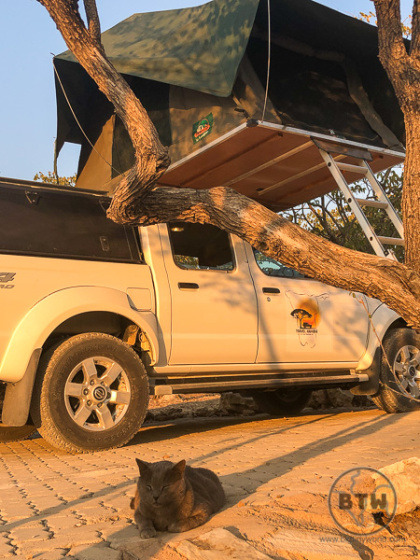
The truck itself really did become our home during those three weeks. It ran well and never let us down, despite the rough conditions we subjected it to. And against all odds, we didn’t get a single flat (Kato said we were the first!).
The tent was remarkably comfortable, and we looked forward to crashing each night in its cozy interior. All in all, it wasn’t a bad way to live for those weeks.
We loved renting from Travel Namibia, and we happily recommend them. You can find their booking details here.
A day in the life
06:27 – wake up to the birds beginning to stir, along with some of our early-riser neighbors
06:36 – finally drag ourselves out from under the warmth of our comfy sleeping bags, apply some deodorant, throw on some extra layers, and don a hat or a buff
06:42 – Aaron pulls out the propane tank, a pot, and a couple of bowls to start heating up some breakfast: the usual chakalaka or beans poured over rice and spruced up with our all-purpose seasoning, paired with rooibos tea with honey. Meanwhile, I pack up as much of the tent as I can without his assistance
06:45 – Aaron helps pack in the excess fabric of the tent while I slowly fold it up, and we get it all strapped down and covered. Breakfast heats on the stove
06:51 – we scoop up breakfast and pack up everything else into the truck
06:54 – we take our bowls and tea cups up to the watering hole to hopefully catch some early wildlife while we eat; nothing comes
07:26 – we drive out to the camp gate to await the new day
07:28 – the gates are already open, so we’re off!
07:49 – we pull over to take some pictures of an early morning jackel
07:55 – we reach our first watering hole, where we spy a few hyenas
08:37 – we stop to photograph some wandering wildebeasts, ostriches, and the ever-present springbok
09:23 – we spot our very first lions! thanks to the help of some other stopped vehicles
09:37 – we stop to hang out with a giraffe for a little while
10:08 – we see a lone elephant off across the field
11:50 – we arrive at another watering hole and park for a bit
11:52 – a huge herd of zebras come into the watering hole, and we take loads of pictures
12:12 – another watering hole; this time, springbok and oryx
12:18 – we notice a hornbill in the trees!
12:51 – wildebeasts and zebras on the side of the road
13:10 – a new watering hole with lots of black-faced impala chasing each other around
13:21 – elephants race into the area, scattering the impala and taking over the scene
13:43 – giraffes finally have a go at the water as the elephants disperse
14:08 – we finally leave the watering hole
15:26 – we stop in at one of the campgrounds to break for lunch: some leftover rice and chakalaka
16:02 – we start to head back in the direction of our campground
16:26 – we spot another lone elephant in the distance
16:38 – we come across a single rhino nearby!
17:03 – we arrive early back at our campground, well before the gates will close at sunset at 18:30 and set up the tent
17:13 – we take a fast shower (only if it’s warm enough, as most showers are open-air)
17:39 – we heat up some quick dinner: mixing it up with some potatoes and beans with our special seasoning
17:58 – we walk over to the watering hole inside our campground for the evening show and see a herd of elephants are already there!
18:14 – a rhino also shows up on the scene
18:31 – the rhino gets a bit too close, sparking a confrontation with one of the larger elephant bulls
18:41 – a small feral cat skitters across the area surrounding the watering hole
18:48 – the elephants finally depart, leaving the rhino alone at the water
19:17 – a flock of birds invades the watering hole, raising a boisterous chorus where it was silent only moments before – a nightly occurrence
19:41 – we call it a night and return to our campsite to get ready for bed, the early sunset training us to tire much earlier in the evening
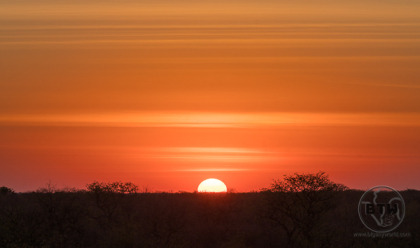
20:01 – we wind down the evening with a quick episode of anime on our iPad, at the perfect height when draped over one of the bungee supports inside the tent
20:42 – after what actually ended up being two episodes of anime, we finally turn off our solar-powered puff lantern (also conveniently hung from another bungee support) and snuggle into our sleeping bags to crash and get up early the next morning to do it all over again!
General truck tips
Stay alert while driving. Distances in Namibia are quite long, and it’s easy to zone out. Take regular breaks to take in the scenery and rest your mind for the next long haul. This could also save you from making costly mistakes that could lead to rolling the vehicle or hitting something in the road.
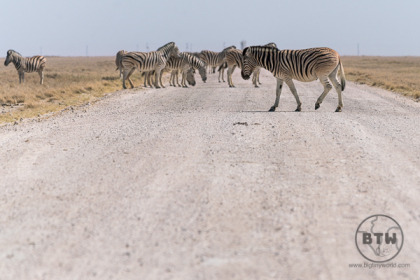
Watch for wildlife. There aren’t many fences to protect the roads, and you’re likely to encounter anything from springbok and warthogs to cows and goats. They can appear suddenly, so always be on the lookout.
Don’t drive at night. The abundance of wildlife is the primary reason. There are no street lights, and animals are more active at night. Besides, it isn’t much fun to drive at night (or have to set up the tent after dark). It’s much more enjoyable to spend this time stargazing, instead.

Keep your windows closed while driving through cities. Sadly, petty crime is quite common, particularly in the populated areas. Open windows are an invitation for quick grab-and-run. Even in smaller towns, many poorer citizens will take every opportunity to convince tourists to purchase their wares (usually handmade bracelets and other trinkets). It’s easier to say no with closed windows (and only open them if you’d like to actually buy something from them).
Be mindful of areas where you can get out of your vehicle. This is particularly true in Etosha National Park. With the abundance of dangerous wildlife, you should stay inside your truck at all times. Only exit in designated areas.
Resist the urge to speed. With the road conditions in Namibia, this should be a no-brainer. Washboard roads already aren’t pleasant at high speeds, and speed on gravel is a recipe for an accident (or a punctured tire). Besides, the views are worth taking in – not passing by.
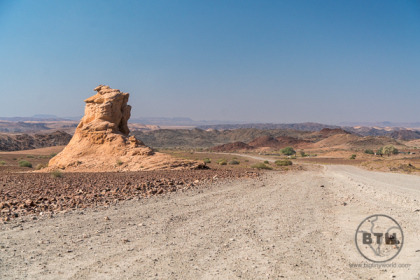
If someone passes you, slow to let their dust clear. Don’t be that person who insists on being the fastest on the road (see the point above). If someone wants to pass, just let them.. and then let their dust clear. Hanging out in someone’s dust cloud reduces visibility and could increase your risk of a rock in your windshield. We seldom even encountered other drivers on the road (usually other travelers), so it wasn’t an issue to just slow down when we did.
Carry your passport. You should do this anyway. But it’s particularly important in Namibia, as you might encounter periodic checkpoints on the roads. Officers (sometimes pretty imposingly armed) might ask for your destination, identification, and if you’re transporting any produce. Some larger vehicles were even stopped and inspected, though we weren’t really subjected to this.
Know the names of the places you’ve left and where you’re going next. We were asked this everywhere we went: every new campground, park, attraction, and checkpoint. Should you go missing, there is a paper-trail log of where you’ve been and where you intended to go next – much like a through-hiking registry.
Memorize your license plate number. This goes with the above. Every campsite we checked in at asked for this, and we were caught, on more than one occasion, needing to dash quickly outside to remember the elusive digits on our license plate. It wasn’t until one of our last days that we realized our helpful rental agency were kind enough to jot this down right on the keychain.. doh!
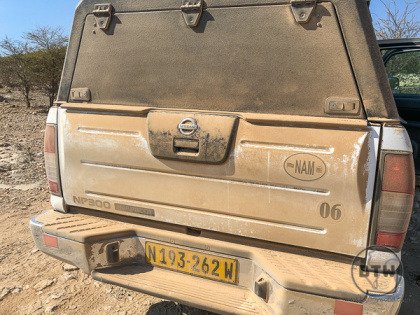
When driving on dirt, open the canopy vent. Thats right: open the vent on the back of the truck. This sounded entirely counterintuitive to us; wouldn’t opening it let more dust in? But no! This actually breaks an otherwise vacuum situation, which would suck in dust kicked up from the rear tires. We made the mistake of forgetting to open this only once, and our things were simply covered in dust. There’s honestly no preventing dust, but this reduces the intensity.
Use four-wheel drive only when you need to. This should be very rare. We only used it once; two-wheel drive was sufficient for almost all conditions. I could see our needing this more during the wet season, but we were fine during the winter. And even if you do need it, familiarize yourself with how to engage it and which situations require which gears.
First, only switch the drive mode while the vehicle is at a complete stop. Use four-wheel low when driving very slowly (generally over very uneven and solid, boulder-road situations), and use the high gear if you’ll require more speed (like the soft-ground situations we had going to Deadvlei). Don’t push the engine too much while in these gears, or you might wear out the clutch.
Fill up as soon as you see the gauge beginning to drop below the F(ull) indicator. Our truck had two gas tanks. This meant we could fill up less frequently, but with gas stations being sparse on the desert roads, you really want to take advantage of them. Our truck burned the spare tank first, so the indicator only moved once we started using the fuel in the second/primary tank. We filled up every time we noticed the needle falling below F, which ensured we never ran out of gas.

Regularly check your tire pressure. This is important to monitor for any impending flats. If you notice the pressure declining, get it checked out (many gas stations offer tire repair service) before it becomes a more costly repair. And as desert temperatures fluctuate drastically, maintaining your tire pressure within the optimal range could protect your tires from punctures.
Final thoughts
Fair warning: renting one of these trucks is expensive. All in, our truck cost us about N$1586 ($110 USD) per day (for two people). They’re very popular, and you will see countless others on your journey through Namibia. But it’s clear to see why. The places this truck took us, and the fact that it served as both our transportation and lodging (not including campsite fees) for the three weeks, it was well worth the cost.
Have you ever stayed in one of these trucks? Tell us all about your experience in the comments below!
We were not offered any discounts or free services by Travel Namibia in exchange for a positive review. While we later agreed to provide them some promotional materials and a mention on our blog – for which we are being compensated – we do this because we genuinely enjoyed our experience with them and would wholeheartedly recommend their services to our friends and family.
Like this post?
Every like, comment, and share helps us grow, travel more, and continue to share amazing stories like these with you!
Pin it for later!


Don’t miss out on new posts! Follow our blog for new posts every week.
We spent 20 days in a #4x4 #camping truck. Click to get the inside scoop on all you need to know about #renting and driving one of these trucks in #Namibia! #drivenamibia #desertcamping How does one see Namibia? Full of wildlife, massive sand dunes, and vast distances, there's really only one way to see it all: renting a car and driving yourself.
2 notes
·
View notes
Text
How Nicholas Hoult’s Trainer Got Him into Superhero Shape
If your connection with Nicholas Hoult starts and ends on About A Boy and Skins, you’re missing out. At 31, Hoult has become one of the most interesting British actors.
In the last few years alone, he has made outstanding twists and turns at acclaimed indie shows like Yorgos Lanthimos’s The Favorite, Justin Kurzel’s True History of the Kelly Gang and Taylor Sheridan’s upcoming The Who Wish Me Dead, where he can assert himself alongside Angelina Jolie. Not to mention, he was reportedly a hair’s breadth away from snatching Robert Pattinson’s Batman role.
All of this means that Nicholas Hoult is a very serious actor, as his most recent Golden Globe nomination can attest. And like the best actors, he’s not afraid of physical transformation should the role require it. And nowadays most of them do.
Fortunately, Hoult has had one of the best British coaches in his corner since that day.
“I went to school with Nick. I’ve known him since I was 13, ”explains PT and co-founder of Before The Lights, George Ashwell. “He came to my school after doing About A Boy. It was common knowledge that he starred in the film. We became friends through playing basketball. “
While Hoult embarked on the aspiring actor’s path, Ashwell studied sports rehabilitation before co-founding Before The Lights, a private exercise room that combines personal training, injury rehabilitation, and nutritional counseling.
It wasn’t long before their professional paths crossed again.
“Nick did X-Men: First Class when I graduated,” explains Ashwell. “He put me in touch with one of the trainers for another performer who was looking for a therapist. I was with this guy for 8 years and also trained Nick for every other X-Men film. ”
In order to transform the relatively small Hoult into the imposing mutated scientist Hank McCoy – alias: Beast – Ashwell prescribed a regime of functional lifting with an emphasis on building muscle while maintaining mobility.
However, it would be the 2015 apocalyptic high octane road movie, Mad Max: Fury Road, that would be the couple’s biggest challenge.
Training for Mad Max
Between the X-Men films, Hoult had to take on the role of desert-living, soil-nourishing henchman and hero Nux.
“We had to really thin him to play this crazy, lawless kid,” explains Ashwell. “He had to be super slim and sinewy, like he was fighting for food. At the same time he is also a fighter. “
With the filming over an extended period of time in the Namibian desert (the film had a notoriously lengthy production), Hoult was left with no real equipment to train on, which meant he had to get creative.
“Nick always knew how to jump, but he really taught himself how to jump properly for the role,” says Ashwell. “They were filming in the desert and didn’t have a lot of access to a lot of things, so he started his day with up to 40 minute direct jumps and got really good at it.”
The length of the shoot also brought its own challenges. Namely, how do you maintain muscle mass while leaning over a period of months?
“The concern was about losing muscle mass while losing weight,” explains Ashwell. “He had to eat the right foods to make sure he was getting his protein intake. Nick had quite a lot of muscle mass before and you have to be pretty motionless to actually lose muscle mass. So his muscle base made him look sinewy. “
As with any training plan, balance was key. During the five-day week of shooting, Hoult stuck to lean food, allowed himself to regain nutrition and have a few drinks with cast colleagues on the weekends.
Switch to Beast mode
Confident that Hoult was in a good place and had the knowledge and discipline to stick to the diet and exercise plan, Ashwell left it up to him, checking in occasionally from his base in London.
Shut downGetty Images
That Hoult would deviate from the plan was never a problem.
“There are two extremes with customers,” says Ashwell. “Some are like Carl Froch; they stay in pretty good shape all year round. Some are like Ricky Hatton; They get really fit for the role, smash it, and then let them do whatever they want until the next role shows up. Nick is definitely the former. He likes to train and he likes sports, he stays in this zone. “
So ridiculously talented, nominated for a Golden Globe and constantly mentioned as a contender for the next Bond role. At least he’s not good at anything else, is he?
“Nick is one of those guys who’s good at anything. He had never played basketball before; I introduced him when we were 13 and the next year we both played for the county together, ”says Ashwell. “He’s one of those who pick up on everything. He drives car and motorcycle races, boxes and does jujitsu. He’s one of those people who love a new ability, he’s really committed to it. “
Okay, cue the workout.
Nicholas Hoult’s “Get Shredded” workout
This workout not only builds your shape, it will absolutely tear you apart at the same time. Try six to eight rounds and build resilience every week.

Philip Haynes
Battle ropes, 1 min
Hold the ends of the rope at arm’s length in front of your hips with your hands shoulder width apart. Support your core in a high squat and alternately begin explosively raising and lowering each arm. Hold alternating arms for a minute

Dumbbell bench press, 20 reps
Lie on your back on a flat bench and hold a pair of dumbbells across your chest with your arms straight and palms facing forward. Before you begin, pull your shoulder blades down and together, holding them as tightly as possible throughout the exercise. Lower the dumbbells to the sides of your chest, pause, and then slide them back to the starting position. Extend your arms fully on each rep.

Side lunges with weight, 20 reps
Stand with your legs under your hips with a kettlebell or dumbbell in your hands. Kick your right leg to the side and lower your body as you bend your knee, keeping your left leg straight. Drive yourself back to the starting position and repeat on the other side.
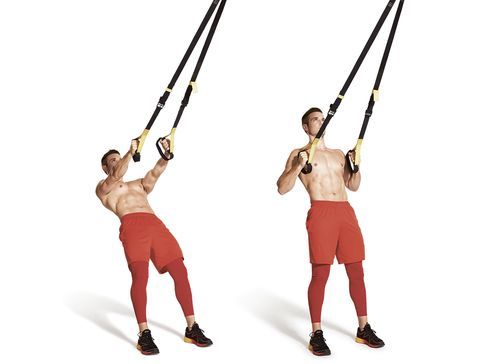
TRX rows, 8 wide, 8 narrow
Lie under the TRX, grab the handles and lift your body. Do 8 rows with your elbows close to your body and 8 with your elbows wide, in line with your shoulders.

Commando Plank, 10 repetitions per arm
Start in the standard plank position, resting on your hands and toes, with a neutral spine, drawn in abs, and a long neck. From there, lower yourself down to one forearm at a time and then back down onto your hands.
This content is created and maintained by a third party and imported onto this page to help users provide their email addresses. You may find more information on this and similar content at piano.io
source https://livehealthynews.com/how-nicholas-hoults-trainer-got-him-into-superhero-shape/
0 notes
Text
How Nicholas Hoult’s Trainer Got Him into Superhero Shape
If your connection with Nicholas Hoult starts and ends on About A Boy and Skins, you’re missing out. At 31, Hoult has become one of the most interesting British actors.
In the last few years alone, he has made outstanding twists and turns at acclaimed indie shows like Yorgos Lanthimos’s The Favorite, Justin Kurzel’s True History of the Kelly Gang and Taylor Sheridan’s upcoming The Who Wish Me Dead, where he can assert himself alongside Angelina Jolie. Not to mention, he was reportedly a hair’s breadth away from snatching Robert Pattinson’s Batman role.
All of this means that Nicholas Hoult is a very serious actor, as his most recent Golden Globe nomination can attest. And like the best actors, he’s not afraid of physical transformation should the role require it. And nowadays most of them do.
Fortunately, Hoult has had one of the best British coaches in his corner since that day.
“I went to school with Nick. I’ve known him since I was 13, ”explains PT and co-founder of Before The Lights, George Ashwell. “He came to my school after doing About A Boy. It was common knowledge that he starred in the film. We became friends through playing basketball. “
While Hoult embarked on the aspiring actor’s path, Ashwell studied sports rehabilitation before co-founding Before The Lights, a private exercise room that combines personal training, injury rehabilitation, and nutritional counseling.
It wasn’t long before their professional paths crossed again.
“Nick did X-Men: First Class when I graduated,” explains Ashwell. “He put me in touch with one of the trainers for another performer who was looking for a therapist. I was with this guy for 8 years and also trained Nick for every other X-Men film. ”
In order to transform the relatively small Hoult into the imposing mutated scientist Hank McCoy – alias: Beast – Ashwell prescribed a regime of functional lifting with an emphasis on building muscle while maintaining mobility.
However, it would be the 2015 apocalyptic high octane road movie, Mad Max: Fury Road, that would be the couple’s biggest challenge.
Training for Mad Max
Between the X-Men films, Hoult had to take on the role of desert-living, soil-nourishing henchman and hero Nux.
“We had to really thin him to play this crazy, lawless kid,” explains Ashwell. “He had to be super slim and sinewy, like he was fighting for food. At the same time he is also a fighter. “
With the filming over an extended period of time in the Namibian desert (the film had a notoriously lengthy production), Hoult was left with no real equipment to train on, which meant he had to get creative.
“Nick always knew how to jump, but he really taught himself how to jump properly for the role,” says Ashwell. “They were filming in the desert and didn’t have a lot of access to a lot of things, so he started his day with up to 40 minute direct jumps and got really good at it.”
The length of the shoot also brought its own challenges. Namely, how do you maintain muscle mass while leaning over a period of months?
“The concern was about losing muscle mass while losing weight,” explains Ashwell. “He had to eat the right foods to make sure he was getting his protein intake. Nick had quite a lot of muscle mass before and you have to be pretty motionless to actually lose muscle mass. So his muscle base made him look sinewy. “
As with any training plan, balance was key. During the five-day week of shooting, Hoult stuck to lean food, allowed himself to regain nutrition and have a few drinks with cast colleagues on the weekends.
Switch to Beast mode
Confident that Hoult was in a good place and had the knowledge and discipline to stick to the diet and exercise plan, Ashwell left it up to him, checking in occasionally from his base in London.
Shut downGetty Images
That Hoult would deviate from the plan was never a problem.
“There are two extremes with customers,” says Ashwell. “Some are like Carl Froch; they stay in pretty good shape all year round. Some are like Ricky Hatton; They get really fit for the role, smash it, and then let them do whatever they want until the next role shows up. Nick is definitely the former. He likes to train and he likes sports, he stays in this zone. “
So ridiculously talented, nominated for a Golden Globe and constantly mentioned as a contender for the next Bond role. At least he’s not good at anything else, is he?
“Nick is one of those guys who’s good at anything. He had never played basketball before; I introduced him when we were 13 and the next year we both played for the county together, ”says Ashwell. “He’s one of those who pick up on everything. He drives car and motorcycle races, boxes and does jujitsu. He’s one of those people who love a new ability, he’s really committed to it. “
Okay, cue the workout.
Nicholas Hoult’s “Get Shredded” workout
This workout not only builds your shape, it will absolutely tear you apart at the same time. Try six to eight rounds and build resilience every week.

Philip Haynes
Battle ropes, 1 min
Hold the ends of the rope at arm’s length in front of your hips with your hands shoulder width apart. Support your core in a high squat and alternately begin explosively raising and lowering each arm. Hold alternating arms for a minute

Dumbbell bench press, 20 reps
Lie on your back on a flat bench and hold a pair of dumbbells across your chest with your arms straight and palms facing forward. Before you begin, pull your shoulder blades down and together, holding them as tightly as possible throughout the exercise. Lower the dumbbells to the sides of your chest, pause, and then slide them back to the starting position. Extend your arms fully on each rep.

Side lunges with weight, 20 reps
Stand with your legs under your hips with a kettlebell or dumbbell in your hands. Kick your right leg to the side and lower your body as you bend your knee, keeping your left leg straight. Drive yourself back to the starting position and repeat on the other side.
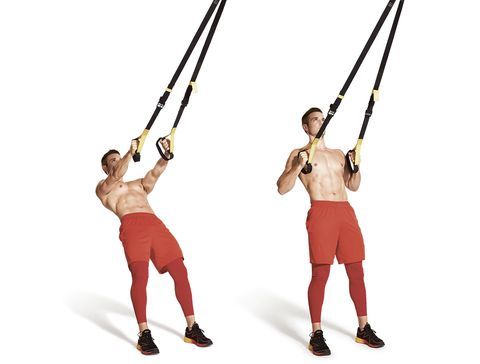
TRX rows, 8 wide, 8 narrow
Lie under the TRX, grab the handles and lift your body. Do 8 rows with your elbows close to your body and 8 with your elbows wide, in line with your shoulders.

Commando Plank, 10 repetitions per arm
Start in the standard plank position, resting on your hands and toes, with a neutral spine, drawn in abs, and a long neck. From there, lower yourself down to one forearm at a time and then back down onto your hands.
This content is created and maintained by a third party and imported onto this page to help users provide their email addresses. You may find more information on this and similar content at piano.io
source https://dailyhealthynews.ca/how-nicholas-hoults-trainer-got-him-into-superhero-shape/
0 notes
Link
Shooting locations can sometimes make or break a film; there are many films in which the location plays a big role in the story. A beautiful or interesting location can really immerse viewers into the movie and enhance the viewing experience.
RELATED: 10 Horror Movie Sets On Which Actors Were Nearly Killed
Some shooting locations can be so exotic or extreme that it can create a difficult or even detrimental situation for production. Here are ten movies with extreme locations, some of which helped the movie stand out, and others that proved to be calamitous.
10 127 Hours (Utah)

James Franco stars in this 2010 survival drama which takes place in Canyonlands National Park, Utah. This movie was filmed on location and director Danny Boyle hired two cinematographers, Anthony Dod Mantle, who had collaborated with Boyle previously on Slumdog Millionaire, and Enrique Chediak to take shifts for the long, grueling days shooting in the canyon.
Franco had to spend a lot of time in a very small space and was often uncomfortable and even in pain during some scenes, which made his job portraying Aron Ralston's harrowing ordeal easier in some ways despite the challenging nature of the set.
9 The Martian (Jordan)

The Martian takes place in the future year of 2035 and tells the story of an astronaut becoming separated from the rest of his crew on Mars in a dust storm and presumed dead. Matt Damon portrays Mark Watney, who must find a way to survive alone on the red planet for the next four years.
Much of the production took place in a village called Etyek just outside of Budapest, Hungary, because it had a huge sound stage that was perfect for filming interiors. For exteriors, however, the crew traveled to Wadi Rum, Jordan. Also known as 'The Valley of the Moon," this world heritage site provided the perfect backdrop for mimicking Mars' vast, alien landscapes.
8 Black Panther (Uganda)

One of the goals for the creators of Black Panther was to have it serve as a homage to several sub-Sahara African cultures while at the same time staying true to the comics. Production designer Hanna Beachler created the world of Black Panther by studying the cultures and technologies of existing tribes and brainstormed how the technology and infrastructure would have advanced had colonialism not interfered.
RELATED: 10 Ways Black Panther Changed The World For The Better
Location was an important aspect in keeping this goal in mind. Black Panther had several locations in which it was shot, including several sound stages in Atlanta, Georgia, on location in South Korea and the Rwenzori Mountains and Bwindi Impenetrable National Park in Uganda. The Bwindi Impenetrable National Park is part of a huge forest of the same name, and it's also named by the U.N. as a cultural heritage site and one of the most biodiverse places on Earth.
7 Predator (Mexico)

The original 1987 version of Predator was filmed in the jungles of Palenque Mexico. This location posed several problems, including extreme temperatures and wet conditions. Heat lamps had to be brought in, and many of the scenes took place on hills and uneven ground. At one point during filming, Arnold Schwarzenegger had to trudge through cold swampy water filled with thick mud and leeches while being chased by the Predator. Schwarzenegger called the experience a "survival story."
6 Monos (Colombia)

This war drama was shot on location in Chingaza National Natural Park, and at the Samaná River in Colombia. Filming for Monos lasted nine weeks in these intense but beautiful places. The jungle scenes, in particular, were unusual for a film shoot because of how remote and untouched by humans the location was.
A base camp had to be established for the crew complete with military tents, and food and equipment were carried up the mountains by donkeys. The crew dealt with heavy rainfall, elevation sickness, and scarce resources like electricity and refrigerated food as they filmed high in the mountains.
5 Apocalypse Now (The Philippines)

Production for Apocalypse Now was famously riddled with problems and struggles. One of the many woes the film cast, crew, and director faced was the difficult location. A huge typhoon rocked the Philippines two months into filming, delaying production for three months.
Even worse, some of the sets were destroyed in the storms. Much of the crew ended up flying back to the U.S. to wait out the conditions. Despite all the difficulties production faced, they eventually overcame them, and Apocalypse Now would go on to win the Palme d'Or at Cannes Film Festival. It's now considered by many to be one of the best films ever made.
4 Mad Max: Fury Road (South Africa)

2015's Mad Max: Fury Road was able to achieve its unique apocalyptic aesthetic by shooting in Dorob National Park, located in one of the oldest deserts in the world, The Namib Desert in South Africa. While the scenery was beautiful, the conditions were harsh; actors dealt with sand, wind, and freezing temperatures at night.
RELATED: Deadpool & 9 Other Movies That Barely Escaped Development Hell
There were also other environmental difficulties in terms of conservation. A leaked report had stated that some endangered plants had been damaged during filming. Despite the rough and destructive nature of the scenes, the claim of environmental damage was later disputed, and the Namibian Coast Conservation and Management Project said that the report was an unfinalized draft and shouldn't have been used to make a judgment call.
3 Lord Of The Rings Trilogy (New Zealand)

This epic collection of movies were made famous thanks to their beautiful scenery and stunning landscapes. In fact, New Zealand has enjoyed an increase in tourism partially due to The Lord Of The Rings, and travelers can go on "Lord of the Rings Tours" where they can visit the movie's actual locations. Over 150 locations in New Zealand were used for the movies, including the city of Matamata and Queenstown, which is a resort town on the South Island.
2 Jaws (The Atlantic Ocean)

Steven Spielberg's decision to shoot a portion of the principal photography on the open ocean caused a few different problems and delays. At one point, one of the boats carrying the cast and crew actually began sinking and had to be evacuated, and a stuntman almost drowned while he was trying to get footage of real sharks to add to the movie.
Because of these difficulties, much of the crew doubted and disliked Spielberg on the set of Jaws, but, in the end, it became the first of many successes. The decision to shoot on the water paid off as the ocean scenes were all the more realistic, evoking danger and a lack of control.
1 The Revenant (Canada)

This rugged and brutal tale finally earned Leonardo DiCaprio his Oscar. The harshness of The Revenant is reflected in its setting. The Canadian Rockies was where much of the scenes were shot, but the cast and crew also filmed in remote areas of Argentina, Italy, and Montana.
There were some crew members that quit the shoot because of intense conditions and freezing weather. DiCaprio stated that wading through freezing river waters for this movie was one of the most difficult tests of his career.
NEXT: 10 Best Movies About Taking On The Wild
10 Movies With Notoriously Extreme Shooting Locations from https://ift.tt/364jblb
0 notes
Text
Tips on Having an Enjoyable Travel Experience

Individuals who frequently travel on regular basis will often discover that traveling without previous preparation is always a mistake you will repent later. The experience that was supposed to be an enjoyable and exciting will eventually prove to be a tragedy. There are in fact many pros and cons concerning the decision on the mode of transport that you may choose for his traveling experience.
Whichever mode you prefer comes with its own merits. Planning for each mode of transportation will differ.
Traveling from 1 location to another usually by car is obviously one of the better options if time isn't an issue and provided the distance isn't too much. In comparison to traveling by airplane, traveling by automobile really offers the traveler many significant benefits. These include flexibility concerning time as well as the opportunity to enjoy the scenery along the road. Traveling by airplane may be faster.
But as soon as you get to your destination, you'll need to hire a cab to maneuver around in. But this isn't the case when traveling by automobile. While travel by car has its benefits, it has several hassles of its own. As an example, it's typically quite challenging especially with children around.
To begin with, before the beginning of journey you have to make certain that the car has just gone through proper servicing in the garage. The gas has to be sufficient and you'll have to get a fantastic map to guide you during your journey. It's good to receive a checklist and ask yourself some questions before you begin your journey. You would have to ask questions like how long will it take to achieve and if you attracted sufficient cash for your trip.
Check also if there are hotels along your trip. After all, you'll have to have proper rest after long hours of driving.
One of the enjoyable parts in regards to traveling is attracting one's children along. However, the other side is they could also get fairly annoying. This is certain to be the trickiest part because you will need additional effort to manage them. The only way to counter this problem is attempt to predict their behaviour by putting yourself in their shoes. Make it a point to bring along some food because children get hungry easily.
Additionally, toilet trips are extremely necessary especially when your kids are extremely young. If you happen to get near a gas station along the way, figure out whether they have to go to the bathroom. Somehow or another, for some odd reason, kids will mention that they should go to the bathroom. Yes, it can get more than a little annoying. But then, they're just kids right? Besides that, don't forget to bring along their favourite toys, pillows, pacifiers.
Get along some simple medicine for those little emergencies also.
Overall, it's always a good practice to prepare yourself before traveling. Try to anticipate the possible issues that may arise. With the necessary steps in place, your journey should be smooth and enjoyable.
Cheap Adventure Travel Experiences
Affordable adventure travel experiences are cropping up in all manner of destinations from Central America to Eastern Europe and consist of many different activities from over landing to volunteering, however for the best in economical travel opt for camping trips where you can really get close to nature and enjoy a wilderness experience like no other.
Fun and exciting camping adventures can be found worldwide, from the outback of Australia and the national parks of North America into the African bush and European valleys.
Here’s the top 3 best recommendations of the cheap adventure travelling experience
Camping on a Namibian safari - take in the highlights of the fascinating and gorgeous country without breaking the bank. Camping every night enables you to sleep under the stars and actually get under the skin of Namibia.
Provides a step back in time to a Europe of old where life in the backwaters is uncomplicated, country lanes continue to be quiet and ancient forests flourish. Life in lots of the cities, however, is changing quickly, as development occurs in a remarkable speed.
Explore the budget of Eastern Europe - A diverse region where east meets west, Eastern Europe
With such alluring names as St. Petersburg, Krakow, Kiev, Prague and Yerevan, it's no wonder this area of Europe is so popular with travelers. With booming arts and entertainments, the regeneration of historical monuments and mile after mile of untouched nature, travels through Eastern Europe are just as rewarding as they were before the fall of the iron curtain.
0 notes
Text
tagged by: @prxttypeony (thank you darling :D)
rules: answer 30 questions and tag 20 blogs you would like to get to know better
nicknames: Dan, Danie, LittleBlue
gender: Male
star sign: Cancer
height: 198-200cm
time: 0009
birthday: 23/06/1997
favorite bands: NF, Hollywood Undead, Imagine Dragons, FoB.
favorite solo artists: NF, Eminem.
song stuck in my head: Labrinth: Beneath Your Beautiful
https://youtu.be/bqIxCtEveG8
last movie I watched: Incredibles. So keen for number 2!
last show I watched: Brooklyn 99.
when did I create my blog: Around 4 years ago I think
what do I post: Just dumb goof stuff, such as selfie, or memes. I have done some [OC] of poems in the past. But don't know if y'all like them so i stopped.
last thing I googled: flight cost to Sydney
do I have any other blogs: Use to, deleted it.
do I get asks: next to never. Would love more!
why I chose my url: Well my name is Dan, and im not short. Hence, Giant-Dan.
following: 267, lot have deactivated their accounts.
followers: 151, 1/4 or probally bots.
average hours of sleep: 4-5 unless im lucky.
lucky number: 8
instruments: Use to play the guitar, and started to learn the Piano but stopped. I'd love to learn the Piano again and then violin.
what am I wearing: Big as shirt and boxers.
dream job: Running my own business making traditional foods. That or someone who helps others.
dream trip: Legit anywhere as long as I'm with people i love. Long trips with no destination is the best!
favorite food: I could live off sushi, or burritos.
nationality: Namibian, but have an Aussie P.R.
favorite song right now: Remeber this - NF
tagging: @lexii639 @setheverman @upsiddess @thatgeologistchick @askingforcommoncuntesy @ginabreadcookie @iwant---tobelieve do it :D
1 note
·
View note
Text
Day 14: Cape Town, South Africa
I awoke in desperate need of a haircut. I mean, I needed it before I left (the day I was leaving I couldn’t find the time with my guy in NY), but it had gotten pretty ugly and unmanageable. So, time for my first ever international haircut! Do they use the metric system? Will the razor length have the same unit of measure? Must I convert Fahrenheit to Celcius? Must I pay in Swedish crowns? All legitimate concerns.
Before venturing out for a haircut however, I did some easy morning yoga with Merav from Israel. She’s training to be a teacher, and I was a willing student. We kind of just took over some space in the hostel, but it was quite a nice start to the day!
On to the haircut: I walked into Hermanos, and they were an almost comically friendly bunch. They immediately offered me a coffee (I got a flat white), Kyle (my dude who is moving to NY next month, so we’ll be catching a beer then) consulted with me, and overall it was much more of a salon experience than a barber experience. I chatted with Kyle about all things NY and Cape Town, and when it was all said and done, it came out to a mere $25! No Swedish crowns needed! Very pleased with this experience, and now I don’t need to worry so much that my travel hair dryer is a bit weak for my purposes (I clearly only pack the essentials).
The weather was generally very miserable, but at times there would be like 20 minutes of perfect sunshine, then back to ripping winds and driving rain. “That’s Cape Town for you” an Uber driver and I said in unison, followed by an awkward laugh. #local
So, with the terrible weather, I knew this was going to be my Museum Day. First to the District 6 Museum, to learn about the forced relocation of ~60,000 residents of color from District 6 in Cape Town to a much less desirable place in the 60′s. This broke up families/neighbors/social groups, added expense to people’s lives and generally uprooting the way of things. I read stories (many folks are still alive that went through this), saw artifacts, and tried my best to understand this truly horrible period. When I felt it was time to go (could have done so much more reading, but as a slow reader, it was becoming daunting), there was building-rattling wind and rain. “Well, I guess I’m staying here for a while I thought”. I went to the restroom, and when I came back out a moment later, it was sunny. Astounding. So! Off I went for a coffee at a cool and very weird steampunk place, a bite of food from Lekker Vegan (lekker being South African slang for “good/delicious” [it’s also easier to not eat meat here as compared to the Namibian bush]), and then to the Zeitz Museum of Contemporary African Art (MOCAA). I was very excited about this, as I’d been following this museum on the ‘gram and thought it would be right up my alley (it was!)
In the 18 minute Uber ride, I saw the weather change drastically 3 times. “Crazy weather huh?” my driver asked. “That’s Cape Town for you!” I responded, slightly hating myself.
I spent about 3 hours checking out the (pretty wonderful!) art from Africa and the diaspora. Great architecture that won’t be explained well, so check the photos above.
After that, I found a weird temporary “digital art museum” installation, and I walked through it watching short films about Cape Town as I wandered the circular maze structure. If you come to Cape Town, you can skip.
I ambled around the waterfront for a wee bit, and then it started raining like crazy again, so off I went to the highly recommended Bombay Bicycle Shop for dinner. This was a really kitschy but cool spot, it really felt like I was in some far-flung land. I got a steak (so much for no meat) with chili chocolate sauce on it. Magnificent! I chatted with the staff, made some friends, and enjoyed my solo dining experience (once a terrifying notion). The staff also complimented my floral sneakers, which in my mind justified bringing them on this trip.
Back to the hostel to do some work and whatnot, and as I was kind of falling apart at 10pm while on a call, I decided it was time to go to bed for a big day of vineyard touring tomorrow.
0 notes
Photo
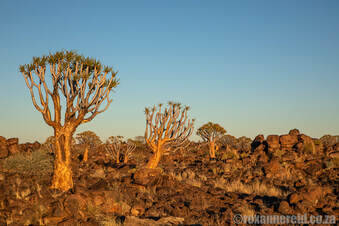
By Roxanne Reid
The stories of Africa’s trees are also tales of its people and animals, from Herman Charles Bosman’s withaak to Rudyard Kipling’s Limpopo fever tree. Think baobabs that are 6 000 years old or marula trees long believed to have elephants stumbling away drunk. In these 10 stories about trees in Africa let’s root out the fables, facts and fictions about some remarkable African trees.
1. Baobab bar
The Sunland baobab in Limpopo is one of the world’s widest; about 30 people could join hands around its trunk. Radio carbon dating suggests parts of it are more than 1700 years old. Old baobabs become hollow and in 1993 Doug and Heather van Heerden, who own the farm where it stands, cleared out the compost build-up in the hollow. They discovered Bushman artefacts and tools that Voortrekkers used to fix their ox wagons. They turned the hollow space into a pub complete with door, railway sleeper bar and draft beer. ‘We’ve had 60 people inside the pub at once,’ says Heather, ‘but a big branch broke so now it’s open plan.’ In April 2017 another part of the trunk collapsed, though the oldest wood is still standing. ‘We’re hoping the broken trunk will start to grow again.’
Where: Sunland Farm, Modjadjiskloof, Limpopo. Sadly, as of May 2019 it is no longer open to the public.
Factfile: Baobabs flower on spring nights and bats pollinate them.
2. Circles in a forest
If you visit the indigenous Knysna forests on South Africa’s Garden Route you’ll understand what inspired Dalene Matthee’s book Circles in a Forest. Ahead of his time, her character Saul Barnard worries about the forest’s survival and the exploitative greed of timber merchants. Matthee died in 2005 and her ashes were scattered at a monument near an 880-year-old Outeniqua yellowwood. The tree towers above the canopy and Saul would be pleased to know it is now protected as a Champion Tree, which may not be damaged in any way. Walk one of the ‘Circles in a Forest’ trails nearby to immerse yourself in the forest atmosphere.
Where: Krisjan se Nek picnic site, Goudveld Forest, Knysna.
Factfile: Outeniqua yellowwood is South Africa’s tallest species, reaching up to 60m. In the past, the trees were used for ship’s masts.
3. Wonder tree
The Wonderboom is a 1000-year-old giant wild fig. Over time its branches drooped to the ground and took root to form a circle of 13 daughter trunks – something not typical of the species. Voortrekkers rested under it in the 1830s. In her 1882 book In the Land of Misfortune Lady Florence Dixie noted that more than 22 ox-wagons and hundreds of people could shelter under it. The mother tree suffered some damage in the early 1900s when people dug holes looking for the Kruger millions. Today its crown is the largest of any South African tree – about half the length of a rugby field. It has been declared a Champion Tree in a Department of Agriculture, Forestry & Fisheries project that protects notable trees.
Where: Wonderboom Nature Reserve, Pretoria.
Factfile: Local legend claims it’s so huge because a tribal chief is buried under it. The summer fruits turn yellowish-pink when ripe.
4. Safe house poplar
A skinny Lombardy poplar outside the safe house belonging to Ruth Fischer Rice was a beacon of hope for people on the run during apartheid. Ruth’s father, activist Bram Fischer, led the legal team that defended Nelson Mandela and his co-defendants during the 1963/4 Rivonia Trial. Although the prosecution wanted the death penalty, the team secured a sentence of life in prison. This changed the course of history, allowing Mandela to become South Africa’s first democratically elected president in 1994. ‘The people who stayed with us were mainly young men and a few young women referred to us by people we knew,’ Ruth remembers. ‘Some stayed for several months. There was surveillance but we were never raided. A storm-water drain ran from our street to the neighbouring [Johannesburg] Country Club, through which our son could lead anyone who needed to escape.’
Where: Corner of Lothbury and Fawley avenues, Auckland Park, Johannesburg.
Factfile: The poplar tree is a fast-growing alien that sends out suckers – even from the stump after it is cut down.
5. Spring glory
Zimbabwe’s musasa trees (also known as igonde, msasa and mutsatsa) drop their leaves in winter. Then, for just three weeks each September, the new leaves create a blaze of colour before they turn green for summer. ‘They are a variety of tones from palest blush to burnt orange and burgundy, with gold and reds in between,’ says artist Lin Barrie, who completed a series of paintings inspired by this spring colour. ‘Musasas were part of my early bush experiences, with branches to climb on, colour to marvel at and carpets of flowers and mushrooms beneath. My father was a keen walker and birder and as a child I often went with him on excursions to the musasas. They were the backdrop for birds like spotted creepers, owls and pennant-winged nightjars.’ Lin’s oils and acrylics of natural scenes are in collections around the world.
Where: Mukuvisi Woodlands in Harare, Zimbabwe, in September.
You can see permanent displays of Lin Barrie’s art at her studio in Borrowdale Brooke Estate, Harare, or at the Cape Gallery in Church Street, Cape Town.
Factfile: The orange caterpillars of the musasa moth appear in masses in March to feed on the trees.
6. The lion fig
‘Just north of Busanga Bush Camp in Zambia’s Kafue National Park lies an enormous sycamore fig tree on elevated ground,’ says safari guide Isaac Kalio. ‘The local tree-climbing Busanga lion pride likes to rest in the horizontal branches, so although it’s a beautiful picnic spot you first have to check who’s there! It produces four fruit crops a year that attract many animals. Tiny wasps breed inside the fruit and are in charge of pollination. The sycamore fig has been incorporated into Zambian teaching about HIV/AIDS because just as you can’t tell by looking at the outside of the fruit if it contains insects, you can’t tell by looking at someone’s face if they are HIV positive.’
Sad news is that this particular sycamore fig tree at Busanga fell in April 2019.
Where: 500m north of Busanga Bush Camp, Kafue National Park, Zambia.
Factfile: The genus is 60 million years old and the sycamore fig was mentioned in the bible.
7. Symbols and stamps
The quiver tree is Namibia’s national tree and a symbol of the south, where it grows in rocky areas of desert and semi-desert. It got its name in the 17th century when Dutch Cape colony governor Simon van der Stel learnt that the San hollowed out its tube-like branches to make quivers to stash their poisoned arrows during the hunt. The trunks of dead quiver trees were also used as natural fridges to store water and meat because the fibrous tissue has a cooling effect as air passes through it. A member of the aloe family, it is protected in Namibia. It featured on Namibian postage stamps five times between 1961 and 2010 and appears on the Namibian 50c coin. Quiver trees were declared endangered by the International Union for Conservation of Nature (IUCN) in 2010.
Where: Quiver tree forest 14km northeast of Keetmanshoop, Namibia.
Factfile: The quiver tree can live 100-200 years but only starts flowering at 20-30 years and has bright yellow flowers in winter. It is well adapted to hot, dry climates but coming under increasing threat from climate change.
‘Yes, there on the grass, in the shade of the withaak, the leopard and I lay down together. The leopard lay half curled up, like a dog, and whenever I tried to move away, he grunted. I am sure that in the whole history of the Groot Marico there have never been two stranger companions engaged in the thankless task of looking for strayed cattle.’
Herman Charles Bosman, In the Withaak’s Shade
8. Oom Schalk’s tree
When Herman Charles Bosman’s character, Oom Schalk Lourens, lay down to rest in the shade of a withaak (white thorn) tree while supposedly looking for lost cattle, he imagined the tip of his boot was a hill called Abjaterskop. Before long a leopard appeared on the hill and started sniffing his feet. Its breath swept over his face in hot gasps as he lay paralysed with fear. Then the leopard turned and lay down next to him half curled up like a dog. Bosman’s deceptively simple satire brings alive the scenes and characters of the hardcore bushveld and mampoer country of the Groot Marico. Sadly, this story from Mafeking Road ends with a red splash on the leopard’s breast from a Mauser bullet.
Where: North of Groot-Marico town, North West.
Visit the Bosman literary festival each October at the Bosman Living Museum in Groot-Marico, a replica of the school where Bosman taught in the 1920s.
Factfile: The long thorns are whitish or bluish in colour, giving rise to the dual names of withaak (Afrikaans for white thorn) and blue thorn/blouhaak. White spiky flowers appear from August to October.
9. The manhood tree
The most noticeable thing about the sausage tree is its sausage-shaped fruit, which can grow as long as your arm and weigh up to 10kg. ‘In some parts of Africa, people use the fruits to enlarge their manhood,’ says safari guide Livingstone Sana. ‘With the instruction of a traditional healer, a boy climbs up the tree and chooses a young fruit. He cuts a round hole in it to mark his size then leaves the fruit to grow. When it gets to the right size he climbs the tree again and cuts the fruit down without touching it so that it doesn’t continue growing too big.’
Where: Just north of Little Makolololo Camp, Hwange National Park, Zimbabwe.
Factfile: The flowers, which open at night, have an unpleasant smell that attracts bats to pollinate them.
10. The tree of life
The marula is called the tree of life for its many uses from food to medicine. ‘It’s a photographer’s best friend in summer when leopards climb it for shade,’ says Londolozi ranger Alistair Smith. ‘The growth structure provides comfortable platforms for them to rest. Other animals almost guaranteed to be near a summer-fruiting marula are elephants. Once they’ve eaten the fruit off the ground they often shake the tree so more crashes down.’ He adds, ‘Male and female parts are on different trees so Shangaan people believe a pregnant woman who wants a daughter should drink tea made from the bark of a female tree; for a son, she drinks tea made from the male tree.’
Where: Londolozi in the Sabi Sands Game Reserve, Mpumalanga.
Factfile: The green African moon moth breeds on the tree. The fruit is made into beer and the ever-popular Amarula liqueur. That the fruit makes elephants drunk is a myth.
Note: This article first appeared in British Airways’ High Life magazine with wonderful watercolour illustrations by Hazel Buchan.
Like it? Pin this image!
You may also enjoy
Magical treehouse in the Baviaanskloof
Voices of Botswana: the tree man of Ngoma
Copyright © Roxanne Reid - No words or photographs on this site may be used without permission from roxannereid.co.za
1 note
·
View note
Text
What’s up for Elephants?
Annual Review 2017
Written by Erika Mansourian, with Anne Dillon and Patricia Sims

Founder’s Note:
This year marks our 6th Annual World Elephant Day campaign. We here at World Elephant Day are very proud of how the day has grown year after year after year. Our global media reach continues to blossom, signifying that our impact is ever-expanding — which means that increasing numbers of people are becoming conscious about what’s really at stake for the elephants.
For World Elephant Day, one of our goals has been to put together an annual review of what’s happened in the world for elephants over the past year: the milestones, the successes, and the work that still needs to be done.
For this year’s review, our guest writer is Erika Mansourian, a well-known and passionate elephant advocate and conservationist who has worked with several elephant organizations. Anne Dillon, our Communications Director, works in a variety of capacities on behalf of the elephants. She provided background research for this report, as well as editorial support in the writing of it.
We hope you enjoy it and we look forward to your feedback amid the rumblings and trumpeting currently underway for World Elephant Day 2017!
Elephantically yours,
Patricia Sims
Co-Founder, World Elephant Day
President, World Elephant Society
What are the encouraging developments and the intractable challenges from the world of elephants since last August 12th? We’ll try to take that on in this update, which focuses on the state of the extraordinary but beleaguered elephant. The landscape for elephants, literally and figuratively, continues to shift, so there is more news than we can possibly cover. But here are some highlights, shared with the hope that both the good news and the bad will motivate you to commit your time, skills, and creativity to saving the most worthy of animals. Our greater hope is that one year soon we will be able to report even more positive progress and fewer grim statistics.
In December, China made a stunning announcement: it will ban all commerce in ivory by the end of 2017. Coming from the world’s largest consumer of ivory, the move may deal a blow to elephant poaching in Africa. This follows on the heels of the Obama administration’s near total ban on the commercial trade in elephant ivory. Hong Kong says it intends to ban ivory by 2021, Japan’s internet retail giant Rakuten Ichiba has ended all sales of elephant ivory, and there have recently been high-profile trafficking busts throughout Southeast Asia, Europe, and the U.S., signaling that the noose is tightening around traffickers of (primarily African) ivory. Of course, far more must be done to reduce the supply, demand, and killing.
That said, with a handful of bold actions offering a glimmer of hope for the African elephant, this year we’d like to emphasize the ongoing plight of the Asian elephant, both wild and captive.
Captive Asian Elephants: A Pachyderm Paradox
There is a stark contradiction in the current state of captive Asian elephant welfare.
Growing Awareness, Changing Behavior
· Well-meaning but uninformed tourists are becoming more aware of the gruesome reality behind the scenes at elephant riding camps and venues where elephants are forced to perform. According to World Animal Protection, 60% of the people it surveyed said they would avoid tour operators whose activities cause suffering to wild animals.
· Circuses that exploit exotic animals are closing down due to diminishing sales, including the most famous of them all, Ringling Bros.
· Legitimate sanctuaries such as Elephant Sanctuary Brazil are opening.
· Ethical elephant tourism guides and lists of places to consider visiting are currently available; they offer advice as to best practices for interacting with and viewing captive elephants and various forms of wildlife.
· Some safari camps are no longer offering rides and other places never have.
· More than 160 travel companies have signed a pledge to stop promoting and selling travel packages that include elephant entertainment. (For a full list of elephant-friendly travel companies, visit World Animal Protection’s site. They include Peregrine, Albatross Travel, Jetair, Qantas Vacations, AAT Kings, APT, Helloworld, Harvey World Travel, and Expedia.)
Elephant Exploitation: Progress is Slow and in Some Places, the Situation is Worsening
Over 3,000 captive elephants in Asia are enduring abuse and neglect, living for years in chains when they’re not being forced to carry heavy burdens of tourists or perform unnatural and painful tricks. Sadly, between 2010 and 2016 there has been a 30% rise in the number of elephants used in tourism in Thailand.
The exportation of wild elephants into captivity is a deflating indication that demand for entertainment and tourism is, in some areas, still thriving. In December, Zimbabwe airlifted 35 wild elephants to a zoo in China, some as young as three years old. As can be imagined, the transport was a living hell for the animals. This June, it was revealed that the Namibian government planned to capture and sell five baby elephants to the Dubai Safari Park in United Arab Emirates. It is believed the elephants would be used for riding, so the brutal practice of “breaking” them in is inevitable.
Wild Asian Elephants: The World Closes In
Human-Elephant Conflict
The problem is straightforward: Too many people and not enough space for elephants. The causes are not as simple — there a just too many of them.
Human population growth threatens elephant territory, most notably ancient migration corridors that elephants have trod for millennia. Seeking new routes, they’re frequently struck by trains or electrocuted. Nearly 300 wild elephants died in India's Orissa State in the past five years; most of the deaths were caused by accidental electrocution. More than 1,200 trains crisscross the country, through some of the most vulnerable wildlife habitats. In the past three years alone, 40 elephants have been killed by trains in India, according to the government.
Elephants in search of food and water frequently rampage villages and attack villagers, who kill them. In Odisha, 388 elephants died in man-animal conflict in just six years.
Industrial development such as the palm oil trade in Sumatra and logging camps and infrastructure expansion choke off the highly limited land for elephants and other wildlife.
Poaching and illegal trafficking is an ongoing scourge throughout India and Asia.
Perhaps most heartbreaking is the capture and smuggling of wild baby elephants in Burma, Laos, Cambodia, Myanmar, and elsewhere to feed the appetite of the tourism trade.
Solutions Planned or in Place
The solutions for protecting wild elephants can be as varied as the problems. Recently, a panel of experts shared their ideas for better co-existence. Foremost is pushing conservation to a higher priority on the political agenda, giving a voice to suffering human communities, and promoting the intrinsic value of elephants.
Corridors and Underpasses
In India alone there are 88 wild elephant corridors, making it impossible to secure them all. But both government agencies and NGO alliances are expending resources to create sustainable spaces for jumbos. Villagers are voluntarily relocated to safer areas to ensure their peace of mind, such as 38 families in Assam, India, in 2016.
To address strikes by trains, providing the Indian public with a more complete list of elephant-crossings and lowering train speeds in those areas will hopefully reduce the number of elephant deaths. Beehive fences are increasingly being used to deter crop-raiding pachyderms. The cost is low relative to their effectiveness.
The future of the Asian elephant can seem unnervingly precarious. For many conservation organizations, agencies, and individuals, though, giving up is not an option.
African Elephant Update
As with the Asian elephant, the past 12 months have brought some surprisingly promising news from some African countries, but also a continuing downward trend in others. Census results reflect the contradiction.
Numbers Up, Numbers Down
According to an aerial survey by the Kenya Wildlife Service, there has been a 72% increase in the number of elephants in the Maasai Mara Conservancy and the Tsavo-Mkomazi ecosystems since 2014, and poaching in Kenya generally saw a decline in 2016. It goes without saying —but we’ll repeat the refrain anyway — upticks like these are relatively slim. Kenya will complete a broader elephant survey by the end of 2018.
A shocking 730,000 elephants are missing across 73 protected areas in southern Africa, according to a new study from the University of Pretoria (UP).
Perhaps most troubling of all, this spring an aerial survey of a large swath of northern Central African Republic (CAR), conducted with funding from the Great Elephant Census, a Paul G. Allen Project, observed no elephants at all, nor even any sign of them. Surveys of the area in 1977 estimated 35,093 elephants; by 2010 only an estimated 68 elephants remained in the landscape.
Keeping the Faith: Steady Steps Yield Sustainable Results
Three tourism agencies in China have stated that they will phase out their promotion of elephant riding, and other forms of entertainment at the elephants’ expense, in the travel destinations of India, Sri Lanka, and Nepal.
Beehive fences are being increasingly used in Africa (where they originated). In Gabon — home to 45,000 forest elephants — electric fences are allowing people and elephants to better co-exist.
Elephant riding camps in Botswana and South Africa have ended the practice.
Malawi is in the midst of relocating a total of 500 elephants from the Lower Shire district of Chikwawa to the country’s central grasslands and woodlands.
There has been a decline in the legal trade in China. Indeed, that country’s resolve to ban its legal commercial ivory trade has sparked a dramatic downturn in ivory prices throughout Asia, including in Bangkok’s black market.
For decades Japan has ignored an international ban on poached ivory. Now it’s taking small but meaningful steps to join other countries, while giant retailers also commit to stop the sale of ivory products.
On the trafficking side, in June a cross-border African task force cracked a major ivory trafficking ring moving ivory from Uganda to Singapore by way of Kenya, and in July, the Environmental Investigation Agency published news that the small town of Shuidong in Guangdong province in southern China has been a seminal ivory trafficking hub; 80% of all poached ivory from Africa passes through this one pivot point.
CITES 2016
African elephants and rhinos were front and center at the 17th Conference of the Parties (CoP17) to the Convention on International Trade in Endangered Species (CITES), held in Johannesburg last October. Held every three years, with 183 member countries, the conference had 62 individual proposals under consideration, but with an unprecedented 30% decline in the African elephant population between 2007 and 2014, elephants were high on the agenda. In the past, CITES has sometimes frustrated conservationists with its decisions mired in political interests, but this year it is believed to have had more highs than lows for wildlife protection.
Bans for Conservation and Welfare
Here are a few of the notable rulings and ivory-ban legislation from around the world.
As the largest city in the world, in July of this year New York City set a powerful example by banning all performing exotic animals, and a ban on the use of elephants in entertainment is awaiting the governor’s signature in New York State.
According to the Humane Society of the US, ivory sales are currently illegal in California, New Jersey, New York, Hawaii, Oregon, and Washington State. This year, Nevada joined their ranks. Ivory-ban legislation is being considered in Nebraska, Pennsylvania, Delaware, and Massachusetts.
On the world stage, France announced an ivory ban last August, and last month Hong Kong launched a bill that would ban the import and export of ivory by 2021.
Over in the UK, the Labour Party Manifesto 2017 is calling for a total ban on trade in ivory. Prime Minister Theresa May abandoned her previous commitment to a ban. A startling report last August revealed that thousands of ivory products are on sale throughout Britain. On the upside, last November the country pledged £13 Million ($17 million) to tackle illegal wildlife trade.
Deploying More Tech Tools
The tech industry was initially sluggish in contributing their innovations and products to the battle to save elephants. Rangers, law enforcement, guards, and communities relied on their weapons, their eyes and ears, and a simple determination to protect their wildlife. Now, Silicon Valley is teaming up with conservation organizations, and everything from solar fences to GPS telemetry to whatsapp is helping to level the playing field.
Microsoft co-founder Paul Allen, whose Great Elephant Census was as comprehensive as it was alarming, wants to cover 90,000 square miles of Africa with smart sensors and drones by the end of the year: the Domain Awareness System (DAS) is the most ambitious tech-focused conservation project yet.
Cutting edge DNA barcoding, which uses short DNA sequences to accurately identify species, is becoming an effective courtroom tool for prosecuting wildlife crime. With a grant from Google, the Barcode for Wildlife Project has trained hundreds of law enforcement officials and scientists to use the technology in South Africa and Kenya.
To Crush or Not to Crush?
This month, New York City once again held a crush, destroying two tons of ivory worth about $8 million. Other crushes have been held in other countries around the world. But are they effective? Or do they do more harm than good? This piece asks several wildlife experts for their opinion on the controversial strategy.
The Power of One
Never underestimate the power of one person to make a difference. Stephanie Vergniault fell in love with elephants on her first visit to Chad in 1995, when she saw them in great numbers. As she watched them disappear, the French native knew she had to act. She founded SOS Elephants, the first organization of its kind in Chad, through which she has built support for the anti-poaching cause. The result is that, although challenges remain, elephant protection has become a high priority in Chad.
Fascinating Findings about an Already Fascinating Animal
Each year, new research increases our respect and admiration for the elephants (if that’s even possible).
· Elephants know when their bodies are obstacles to success in a novel transfer task
· Genetic study shakes up family tree
· Elephants born without tusks due to poaching
Alarming Trends
There is a horrific, invasive cactus in Kenya that can kill an elephant when its spines become lodged in the animal’s throat or stomach.
SA National Parks in South Africa is refusing to provide statistics on how many elephants have been poached in Kruger National Park this year. Queries are referred to the Dept. of Environmental Affairs (DEA), which likewise declines to release the figures.
An emerging threat to elephants is skinning — being killed and stripped of their skin, which is sold on the black market, promoted as a medicinal cure or made into beads. The recent discovery of 421kg of elephant skin seized in southwest China confirms this devastating market development.
Wildlife traffickers are using Facebook to sell ivory and rhino horn.
The Telltale Conclusion
The pressures coming at the elephants come from all sides — climate change, toxic land and water, global unrest, and the Sixth Mass Extinction that is well underway. Our most precious resource is the one we can’t make more of: land. How are we to make the most of what we have? How can we preserve the few wild spaces left, to ensure that flora and fauna will survive, and maybe even thrive? It requires innovation, collaboration, and long-term resolve.
For things you can do for elephants all year long, check out World Elephant Day’s ideas and actions. To quote the British explorer Robert Swan, “The greatest threat to our planet is the belief that someone else will save it.”
With that in mind, we’d like to leave you with a thought-provoking question that we’ve dubbed the “One Question, One Word” challenge. Come up with one word to describe what you think is the single most effective tool for saving elephants. And, in three sentences or less, tell us why.
We’ve asked a few elephants conservationists and welfare experts for their views on this; below are their replies.
Send your word and explanation to [email protected] with the subject line
“One Question, One Word” and we’ll share all of your hopeful words with the world in our next newsletter
• Compassion
Most wild animal species that are declining can be considered ecological refugees. If we can invoke compassion in the minds of the pubic for a sentient being that bears so many similarities to us, we can create a powerful force for elephant conservation.
Compassion, or Karuna, is an important concept in Buddhism: the desire to remove harm and suffering from others. Karuna works with Muditha, which is the desire to bring about the well-being and happiness of others.
—Ravi Corea, President, Sri Lanka Wildlife Conservation Society
• Influence
If we, as the governing species on our planet, do not speak up on behalf of elephants and the forests, land, and water that we all need, who will?
—Monica Wrobel, Head of Conservation and Campaigns, Elephant Family
• Community
Elephants will survive best when the community has security, education, and livelihoods.
—Denis Galava, African Wildlife Foundation
• Passage
Elephants are large animals (megaherbivores) and need to constantly move to feed. Unless their right of passage is established over these traditional migratory routes, there will be higher conflict rates and fewer elephants in the future.
—Vivek Manon, Founder and CEO, Wildlife Trust of India
• Oneness
Oneness is important in the elephant welfare movement, as it will create unity, and foster symbiotic relationships. As seen in the natural world where organisms thrive together, we can manifest changes by embracing each other's unique talents, rather than compete or imitate. Every human being has an authentic and necessary gift that needs to be harnessed in order to bring an end to the atrocities against these supremely intelligent and noble animals.
—Sangita Iyer, Founder and President, Voice for Asian Elephants Society and filmmaker of Gods in Shackles
• Integrity
Integrity is key to making a difference overall, because without it amongst all groups involved with elephant protection — from rangers to conservation officials to law enforcers to prosecutors and judges and politicians, as well as funders and NGOs — elephants will not be saved. In every population where poaching is out of control, there is a lack of integrity among at least one of these groups — those who are entrusted to enforce laws and protect wildlife.
—Wayne Lotter, Founder of PAMS Foundation, Tanzania
• Land
Nearly everywhere in Asia elephants are threatened by encroachment on their habitat. India, where humans outnumber elephants by about 50,000 to 1, is a prime example. While it is hard not to sympathize with poor farmers terrorized by crop-raiding elephants, human usurpation of the elephants’ land is illegal, even immoral, and must be stopped.”
—Richard Lair, Consultant on Asian Elephants
• Hope
Hope alone won’t save the elephants, but without it, we don’t stand a chance. With hope comes the belief and the action necessary for us to save the magnificent elephants from extinction.
—Patricia Sims, Co-Founder, World Elephant Day, President, World Elephant Society, Filmmaker of When Elephants Were Young
In our two previous newsletters this year we included excerpts from a prescient message that the renowned French writer Romain Gary (1914–1980) wrote to the elephants, as expressed in a letter published in LIFE magazine in 1967, fifty years ago. We end this update with some more of his words here:
“We never met again, and yet in our thwarted, restricted, controlled, indexed and repressed existence, the echo of your irrepressible thundering march through the open spaces of Africa keeps reaching me, awakening a confused longing. It sounds triumphantly like the end of acceptance and servitude . . . and for all of us who are sick and tired of our polluted cities and even more polluted minds, your colossal presence and the fact of your survival against all odds acts as a God-sent reassurance.
Everything is not yet lost, the last hope of freedom has not yet vanished completely from this earth and, who knows, if we stop destroying elephants and save them from extinction, we may yet succeed in protecting our own species from our destructive enterprises as well.”
1 note
·
View note
Text
The Pitfall of Housing

Some individuals have to reside in substandard housing, and a few others are even forced to live in their cars. Adequate housing has gotten unaffordable for a considerable section of the Namibian population. Recently, affordable housing is now challenging to discover. The expression of affordable housing, in various contexts, also has a neighborhood meaning.
Characteristics of Housing
For lengthy trips, you can rely on corporate or interim housing. Business housing will help you save money in food also. It is the best solution to a lot of problems that business trips create. It will save the company a lot of money when sending employees out on business trips to get rentals. It is such a great way to save money when sending employees out on public business trips. It stands as a win-win option for business travelers and the company, as for the person, it is a very much comfortable option, with all the amenities while it fits in the strictest budget of the company. Business housing for short-term stay is an excellent way to go.
You want the house to convey a welcoming sense. On the flip side, if the residence is merely a convenience that may be replaced by finding somewhere to rent or in case you have little or even no true equity in the house, the considerations are somewhat different. Slow to put in the housing market, both single and married Millennials now are eagerly searching for new homes. Prefabricated homes may have a variety of rooms and be of unique designs. These days, prefab homes have a stunning collection of customization alternatives and are more inclined to be connected with world-class contemporary design than big-box mediocrity. Even people who need to obtain independent homes are opting for gated communities developed by the best housing architects.
Think of ways that you can build your house in stages, making certain that the residence is habitable at a young stage of building. Also ensure that, although you intend to add on to your residence in increments, you plan the full structure of the home up front. Writing your own Craigslist housing wanted ad is a powerful manner of locating a house that fulfills your needs.
Getting the Best Housing
You wouldn't even need to depart from your company housing rental for business. Business housing rentals are ideal for businesspeople who have to travel frequently. They will provide your company with many benefits. They will make your stay very comfortable that you will not mind an extended stay since they are furnished apartments, and give you the comfort of your own home. Some corporate housing rentals also give laundry rooms and internet services. They are the perfect place to stay for your business trip.
The Appeal of Housing
If you decide to remain in a housing society developed by the top rated residential architects, you can delight in a much healthier, cleaner, and a much more relaxing atmosphere. Although such housing societies have not harmed the worth of property in Lahore, due to regional unrest in different parts of the nation, yet they're a huge threat to the properties here. Modern-day housing societies designed by the very best sustainable design architects offer access to world-class facilities at a portion of the price tag.
0 notes